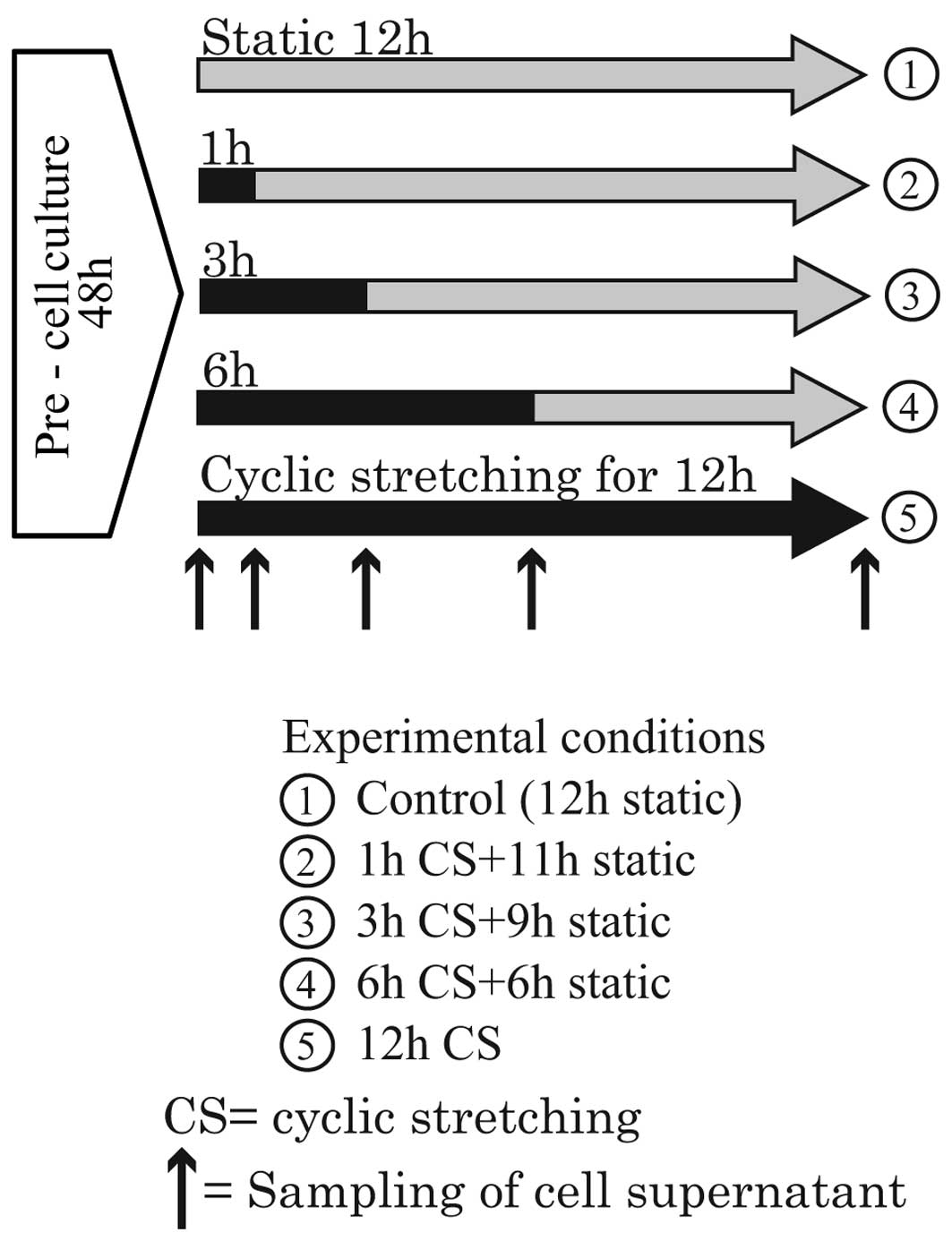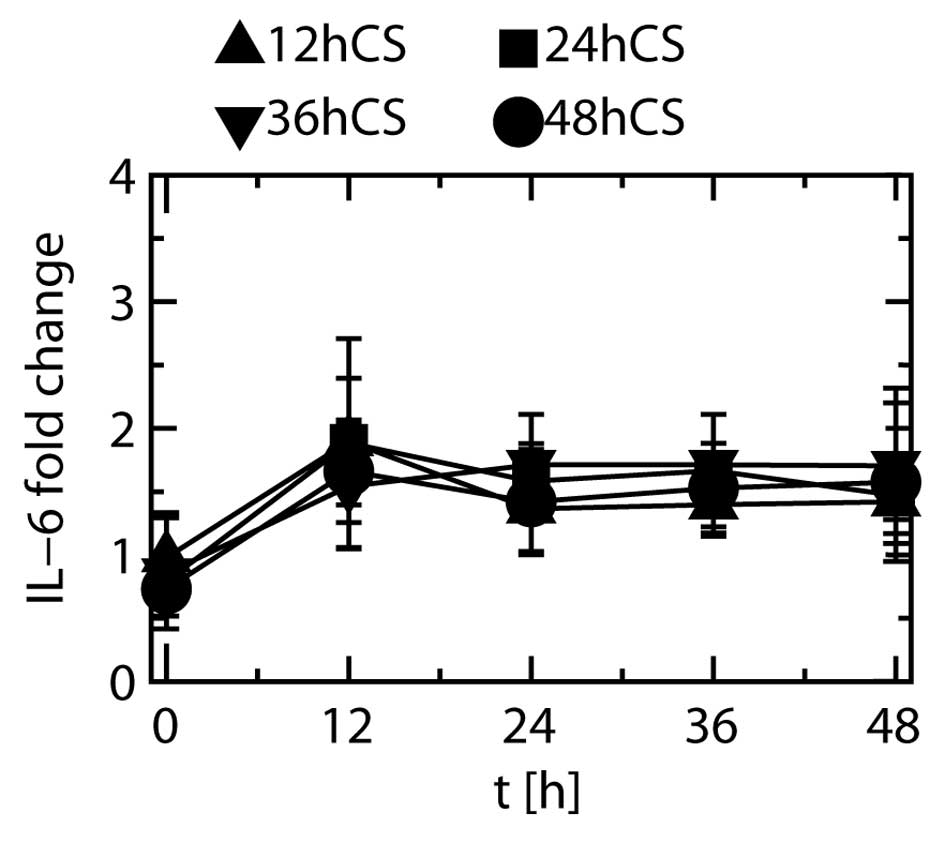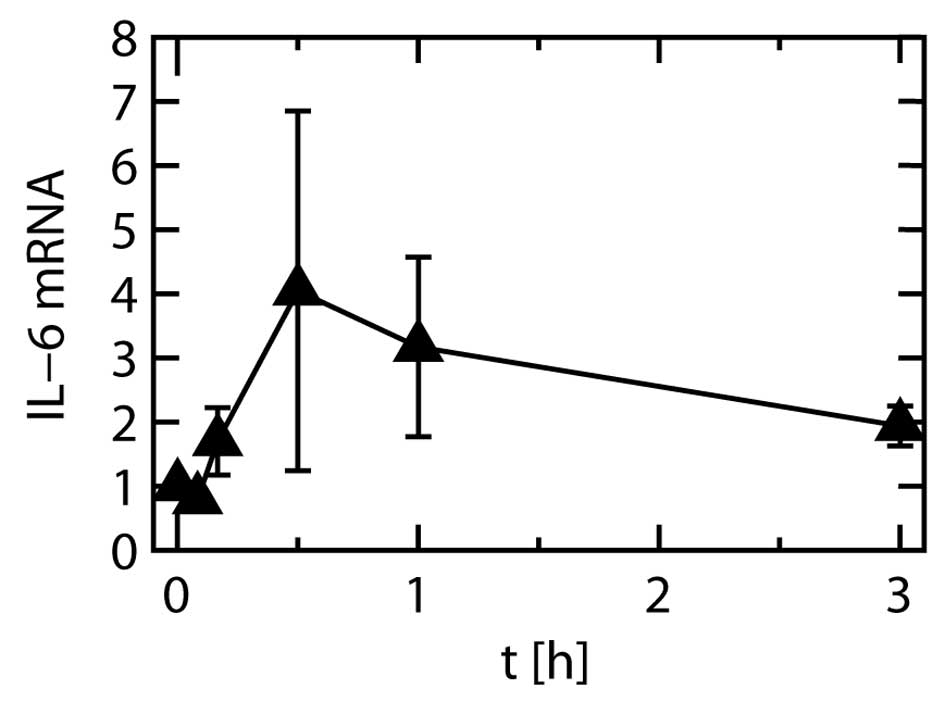Temporal change in IL-6 mRNA and protein expression produced by cyclic stretching of human pulmonary artery endothelial cells
- Authors:
- Published online on: June 11, 2012 https://doi.org/10.3892/ijmm.2012.1023
- Pages: 509-513
Abstract
Introduction
Mechanical ventilators are indispensable for patients with many types of respiratory failure so that vital organs can be adequately oxygenated. However, excessive mechanical ventilation may cause serious complications, one of which is ventilator-induced lung injury (VILI) (1–3). VILI leads to an increase of cytokine and/or chemokine production and alveolar-capillary permeability, promoting protein-rich edema formation, thus impairing gas exchange (4–6). In addition, it is generally agreed that VILI induces multiple organ failure (MOF), which can ultimately prove fatal. It has been suggested that VILI may trigger release of inflammatory mediators into the circulation, thereby exacerbating a pro-inflammatory systemic environment and eventually leading to detrimental effects in distal organs (7–9).
Pulmonary cells are overstretched when volumes in some areas in the lung are increased by mechanical ventilation (10,11). The effects of cyclic stretching have been studied in various cell systems (12–18). Studies in vivo and in vitro have suggested that cell stretching induces gene expression and protein production of various inflammatory mediators, such as tumor necrosis factor (TNF)-α, interleukin (IL)-1β, IL-6, and IL-8 (19,20). Recently, it was shown that the expressions of early response genes [early growth response gene (EGR)1, heat shock protein (HSP)70, IL-1β, IL-6, and macrophage inflammatory protein (MIP)-2] were changed by over-distension of the lungs in adult and newborn rats, before the appearance of overt lung injury (21). In those studies, however, the cells were stretched for only a few specific time periods, and the expressions of the genes/proteins of inflammatory mediators were often assessed only after stretching had been terminated or significant lung injury had occurred. None of the studies investigated the time courses of these changes in expression. Although it is now well known that specific mediators are involved in the pathogenesis of stretch-induced lung injury, only fragmentary evidence of their role in vivo and in vitro has been obtained (20–23). In other words, although the steady state of molecular systems causing VILI has been clarified to some extent, further understanding of the dynamics of these systems is still required.
The aim of this study was to examine time-courses of the gene expression and protein production of IL-6 in human pulmonary artery endothelial cells (HPAECs) when subjected to cyclic stretching. HPAECs were chosen for four reasons: i) To our knowledge, production of IL-6 protein by HPAECs subjected to cyclic stretching has not been investigated in detail in vitro. ii) The inflammatory mediators produced by HPAECs located on the surface of the pulmonary artery would easily pass into circulating blood. iii) Our previous study showed that the strain on HPAECs was nearly equal to that on a flexible silicoelastic membrane on which HPAECs were cultured (24). iv) Among cell lines derived from normal tissues in the lung, only HPAECs were available. IL-6 was chosen because our preliminary experiments had shown that, among various inflammatory mediators, IL-6 protein was that mainly produced by HPAECs subjected to cyclic stretching (25).
Materials and methods
Cell culture
HPAECs (CC-2530; Lonza) were cultured in a growth medium, EGM-2 Bullet kit™, consisting of EBM-2 and SingleQuots™ (human epidermal growth factor, heparin, hydrocortisone, FBS, ascorbic acid, vascular endothelial growth factor (VEGF), insulin-like growth factor (R3-IGF)-1 and GA-1000 (50 mg/ml gentamicin, 50 μg/ml amphotericin B; CC-3162; Lonza). The concentrations of the added factors in SingleQuots are unpublished.
HPAECs passaged 7 times were seeded on 6-well flexible silicoelastic membrane culture plates (BioFlex® Culture Plates; Flexcell International) at a density of 2×104 cells/cm2. The seeded area of the culture plate was where uniform strain was imposed on the cells (Fig. 1). Pre-culture was performed for 48 h (21% O2, 5% CO2, 37°C), after which the cells adhered tightly to the membrane.
Cyclic stretching
A flexcell strain unit (Flexercell® FX-4000T™ Tension System and BioFlex® Loading Stations™; Flexcell International) provided uniform strain on a membrane surface by application of vacuum pressure to a silicoelastic membrane (26). Deformation of the membrane led to the elongation of the cells adhering to its surface (Fig. 2).
Under our experimental conditions, the cyclic stretching comprised 20% elongations with a square waveform of 15 cycles/min, and the ratio of stretching to relaxation was 1:2. The 20% elongation is the maximum achievable with the FX-4000T™ using a circular loading post. Cyclic stretching that exceeds 15% elongation has been reported to be pathological (27–29). The waveform, cycle and ratio employed are equivalent to the clinical standards of mechanical ventilation, and thus mimicked excessive mechanical ventilation.
The longest stretching duration of 48 h was employed for two reasons. One is that the compliance of the membrane remained constant until stretching for 72 h (29), and the other is that the provider of the medium (Lonza) recommends replacement of the medium every 48 h.
Production of cell cytokines
After pre-culture, the cells were stretched for various durations. The experiments were broadly divided into two groups because only four flexible bottom culture plates can be set simultaneously in the Loading Stations™. Thus, four different durations of stretching are possible in a single experiment. In the first group, the durations were 1, 3, 6 and 12 h. During the experiments, the cell supernatant was sampled at the time points indicated by the up-pointing arrows in Fig. 3. In the second group, the durations were 12, 24, 36 and 48 h. During the experiments, the cell supernatant was sampled at the time points indicated by the up-pointing arrows in Fig. 4.
The supernatants of the cells that had been stretched in the two groups of experiments were assayed for the protein concentrations of IL-1β, IL-6 and IL-8 by ELISA (KHC0011, KHC0061, KHC0081; Invitrogen) to clarify whether they had been increased by cyclic stretching.
Real-time RT-PCR
After pre-culture, the cells were stretched for 5, 10 and 30 min and 1 and 3 h. cDNA was synthesized from total-RNA, extracted from the cells before and after stretching (Fig. 5), using an iScript™ cDNA Synthesis kit (Bio-Rad Laboratories, Inc.). The real-time RT-PCR reaction was performed using a DNA Engine Opticon® system (Bio-Rad Laboratories, Inc.) with primers for IL-6. Reaction data were normalized relative to the expression of GAPDH.
Statistical analysis
All measured experimental data are presented as fold-change (means ± SD) relative to control samples. The Kruskal-Wallis and Scheffe tests were used for statistical comparisons of the expression levels of both the IL-6 gene and protein. Significance was accepted at P<0.05. All experiments were repeated 5 times independently (n=5).
Results
Stretching duration and IL-6 protein production
The fold changes shown in Fig. 6 were obtained by dividing the measured IL-6 protein levels by the IL-6 protein level before the start of stretching (0 h). The fold change in unstretched (control) cells appeared to be increased at 3, 6 and 12 h after the start of stretching, but the increase was not statistically significant. When the cells were stretched, many significant differences were found in the IL-6 protein levels at 3, 6 and 12 h relative to those in unstretched cells at the same time points. To show these increases more clearly, other fold changes were calculated by dividing the IL-6 protein levels in the stretched cells by those in the unstretched cells at the same time points (Fig. 7). When the cells were stretched for 1 h and subsequently unstretched, the degree of increase in protein expression remained unchanged from 0 to 12 h. When the cells were stretched for 3 h and subsequently unstretched, the fold change at 3 h was significantly higher than at any other time point. When the cells were stretched for 6 h and subsequently unstretched, the fold changes at 3 and 6 h were significantly higher than that at 0 h, and the fold changes at 3 and 12 h were significantly higher than that at 1 h. When the cells were stretched for 12 h, the fold changes at 3, 6 and 12 h were significantly higher than those at 0 and 1 h.
These results showed that at least 3 h of stretching was necessary to increase the expression of IL-6 protein, and that when stretching was discontinued after 3 h of stretching the protein expression did not increase further.
Expression of IL-1β protein was not detected at any time point, and the level of IL-8 protein showed no significant changes during cyclic stretching (data not shown).
Stretching duration and IL-6 protein production
Fold changes in the expression of IL-6 when the cells were stretched for 12, 24, 36 and 48 h are depicted in Fig. 8. Most of the fold changes observed in the stretched cells showed no significant differences relative to that at 0 h, irrespective of stretching duration.
IL-1β protein was not detected at any time point, and the level of IL-8 protein did not show any significant changes during cyclic stretching (data not shown).
Gene expression
The expression level of the IL-6 gene were significantly increased by stretching at all time points other than 1 min, relative to the levels before the start of stretching. The level peaked at 30 min after the start of stretching (Fig. 9).
Discussion
The levels of IL-6 mRNA and protein peaked at 30 min and at 3 h of stretching, respectively. The difference in the peak times probably reflects the process of IL-6 protein synthesis after the appearance of IL-6 mRNA.
IL-6 protein usually decays in serum in vivo (30,31), but under our in vitro experimental conditions it did not do so, even without stretching. One possible explanation for this finding is that in vivo the IL-6 protein is eliminated by certain enzymes, which are lacking under in vitro conditions. Furthermore, the IL-6 protein is probably released from HPAECs without any stimulation when they are cultured in medium, as has been reported for the culture of human AG01522 fibroblasts (32).
Our finding that even when stretching was continued for 12 h, there was no further increase in the IL-6 protein level compared to 3 h of stretching, was in accordance to the finding that IL-6 mRNA expression was considerably reduced after 3 h of stretching in comparison to its peak (Fig. 9). As IL-6 protein expression was maximal after a specific duration (3 h) of cyclic stretching, it appears that timing is important when investigating interactions among inflammatory mediators and/or their precursors.
Acknowledgements
This study was supported in part by a grant from Kitasato University School of Allied Health Sciences nos. 2010-1049 and 2011-1050 to K.K., no. 2011-1033 to M.N. and a scientific research grant from the Ministry of Education, Culture, Sports, Science and Technology of Japan (no. 23792084) to K.K.



















